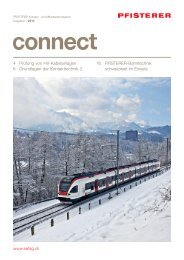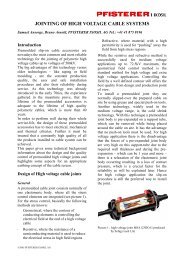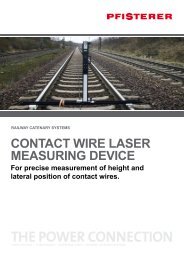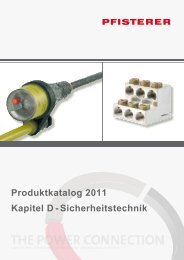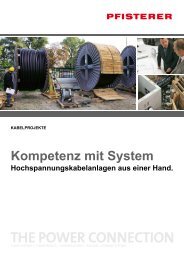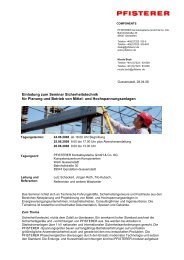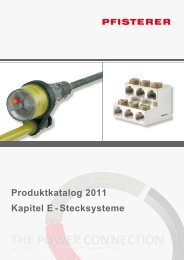10-055_SICON Fachbericht.indd - Pfisterer
10-055_SICON Fachbericht.indd - Pfisterer
10-055_SICON Fachbericht.indd - Pfisterer
You also want an ePaper? Increase the reach of your titles
YUMPU automatically turns print PDFs into web optimized ePapers that Google loves.
<strong>SICON</strong> – The Bolted Connector with Stepless Shear<br />
Bolts for Low-, Medium- and High-Voltage Cables<br />
PFISTERER Kontaktsysteme GmbH presents a completely new type of bolted connector for low-, mediumand<br />
high-voltage cable joints. The patented stepless <strong>SICON</strong> shear bolt allows the joint to be used with a<br />
wide range of cross-sections independent from the cable type.<br />
The <strong>SICON</strong> product programme: cable lugs, connectors and tap connectors<br />
For the past several years clamps, connectors<br />
and cable lugs using screw technology<br />
have been developing rapidly. For good<br />
reasons: bolted connectors offer technological<br />
and practical advantages which<br />
compression connectors do not provide, for<br />
example a large cross-section range and<br />
ease of handling. This clamp technology<br />
is perfectly suited to the new multi-range<br />
cable joints. Fitting only requires a simple<br />
tool – literally in the twinkling of an eye.<br />
In contrast to what is usually required in the<br />
area of compression connector technology,<br />
neither expensive special tools nor special<br />
connecting sleeves assigned to every crosssection<br />
and every cable type are necessary.<br />
This makes storage considerably easier and<br />
ensures quick availability when remedying<br />
malfunctions. The higher individual price<br />
of a bolted connector versus a compression<br />
connector is to a large degree balanced out<br />
by the fact that no special tools are required<br />
and storage and logistics costs are reduced.<br />
Until now the best available innovation<br />
in the area of screw technology has been<br />
the multi-stage breakaway bolt. When<br />
the preset torque is reached the bolt<br />
breaks away, which is supposed to guarantee<br />
the ideal contact force and prevent<br />
the bolt from protruding above the<br />
connecting body. The structural strength<br />
of the multi-stage bolt – the integrated<br />
pre-determined breaking points – is at<br />
the same time its critical weakness. Each<br />
breakaway point disrupts the load-bearing<br />
thread, and the maximum clamping force<br />
cannot be made available.<br />
Protrusion of the clamp bolts must be<br />
prevented as this could damage the covering<br />
joint. To date multi-stage breakaway<br />
bolts have been used in an attempt to<br />
counteract the problem of the smallest<br />
possible protrusion of the clamp bolt<br />
above the connecting body which, with<br />
the multitude of conductor diameters and<br />
Advantages<br />
■ Friction disc for uniform<br />
friction and increased<br />
contact force<br />
■ Up to 30 % increased contact<br />
force compared with conventional<br />
type terminals on aluminium<br />
conductors<br />
■ Nothing protrudes<br />
■ Full utilisation of the thread<br />
loading for any size of conductor<br />
■ No special tool needed<br />
■ Smooth breakage of the shear<br />
bolt simplifies tightening process<br />
■ The remains of the bolt stay on the<br />
tool and can be disposed safely<br />
■ Suitable for fine-stranded Class 5<br />
cables
<strong>SICON</strong> 2<br />
1<br />
2<br />
A standard hexagon key is used to screw a threaded<br />
stud into the hole in the stepless thrust bolt. The force<br />
closure is not interrupted by any steps or notches in<br />
the bolt.<br />
As the <strong>SICON</strong> bolt is screwed in, the friction disc at<br />
the base of the bolt breaks away. The bolt now turns on<br />
this plate; unlike with conventional bolts, no tip friction<br />
occurs on the conductor. The bolt's torque generates the<br />
contact pressure almost independently of the conductor<br />
material. This way, significantly higher contact pressures<br />
are achieved with aluminium conductors and even fine<br />
stranded conductors are not damaged.<br />
3 The <strong>SICON</strong> bolt continues to turn until the shear torque<br />
is reached. The thrust bolt is tensioned as it is screwed<br />
in and, on reaching the shear torque, it stretches axially<br />
and breaks off. Compared with conventional shear bolts,<br />
the bolt breaks very smoothly, almost without a shock.<br />
materials, no manufacturer has succeeded<br />
doing satisfactorily. Even with standardised<br />
conductors there is a multitude<br />
of possible pairings; for example, in accordance<br />
with DIN VDE 0276-603 there<br />
are mathematically 98 variations for<br />
the commonly-used 50 mm 2 – 240 mm 2<br />
connector when all of the cross-section<br />
levels, conductor shapes and conductor<br />
materials are taken into account. However,<br />
a step bolt only has 3 steps. The<br />
result: either the bolt breaks away too<br />
low, and the thread bearing capacity is<br />
not used to its full extent, or it breaks<br />
away too high, and the protruding remainder<br />
must be filed off. Furthermore,<br />
conventional multi-stage breakaway bolts<br />
do not provide for the different materialdependant<br />
torque requirements for aluminium<br />
and copper conductors. Due to all<br />
of these disadvantages compresssion connectors<br />
are still being used in many areas.<br />
“Smart” breakaway point<br />
None of these disadvantages arise with<br />
the new <strong>SICON</strong> screw technology as it is<br />
based on a completely different principle<br />
from the multi-stage breakaway bolt. Although<br />
the continuously adjustable clamp<br />
bolt covers large line ranges, it is still<br />
supposed to generate an optimum level<br />
of contact force and leave behind a<br />
smooth and even fracture surface after<br />
breaking away. PFISTERER solves the problem<br />
with a two-part bolt design: a<br />
threaded stud that is screwed into the<br />
actual thrust bolt causes the screw body<br />
to overstretch, and when the break-<br />
away torque is reached the thrust bolt is<br />
stretched axially and broken off. Because<br />
the area inside the connector cannot<br />
break, it is always the weakest point outside<br />
of the connector that breaks. The<br />
<strong>SICON</strong> bolt is designed such that this<br />
point is always located directly above<br />
the connecting body. In this way the<br />
smallest possible protrusion is attained,<br />
independent of the conductor that is to<br />
be connected.<br />
Risk of injury minimised<br />
When developing the new technology<br />
special attention was focused on safe<br />
assembly. The bolt does not break with a<br />
shock like conventional breakaway bolts,<br />
it is instead slowly stretched to its limit.<br />
This considerably reduces the risk of injury<br />
during assembly. The bolt head that<br />
has broken off remains seated on the pin<br />
wrench and does not roll away unchecked.<br />
Loose metal parts of this sort could<br />
become a serious safety problem in electrical<br />
installations.<br />
The new bolted joints come in many variants<br />
with different cross-sections for<br />
low-voltage and medium-voltage lines<br />
and are used for conductor cross-sections<br />
of <strong>10</strong> to 630 mm 2 . A commercially<br />
available Allen wrench, such as can be<br />
found in any toolbox, is all that is needed<br />
for assembly. Suitably powerful cordless<br />
impact wrench can also be used. For<br />
high-voltage joints, there are special versions<br />
for conductors with cross-sections<br />
of up to 2,500 mm 2 .<br />
4<br />
The <strong>SICON</strong> bolt always breaks even with the surface<br />
of the clamp body. This ensures that the minimum<br />
possible protrusion is achieved every time irrespective<br />
of the size of the conductor to be connected.<br />
<strong>SICON</strong> stepless shear bolts utilise the full thread loading<br />
Conventional shear bolts cannot utilise the full thread loading
<strong>SICON</strong><br />
3<br />
the thread. There is the risk that the screw<br />
thread is broken.<br />
<strong>SICON</strong> connectors are available for low- and medium-voltage cables from <strong>10</strong> to 630 mm 2<br />
and for high-voltage cables up to 2500 mm 2<br />
Technical features<br />
■ Large clamping range: <strong>10</strong> – 95 mm 2 ;<br />
25 – 150 mm 2 ; 50 – 240 mm 2 ;<br />
95 – 300 mm 2 ; 185 – 400 mm 2 ;<br />
300 – 630 mm 2 (others on request)<br />
■ Conductor channels with transverse<br />
grooves and protection against<br />
conductor oxidation<br />
■ Blind hole designed as pressureresistant<br />
oil barrier for oil cable<br />
■ Contact technology type-tested<br />
electrically and mechanically to<br />
IEC 61238-1<br />
■ Compact design: rounded edges and<br />
flat transitions, suitable for slide-on<br />
and shrink joints<br />
■ Suitable for aluminium- and copper<br />
conductors<br />
■ Centric cable guide with different<br />
centring sleeves<br />
Optimum contact force<br />
for all conductor materials<br />
Different conductor materials have different<br />
requirements with regard to the breakaway<br />
torque. When the bolt is tightened,<br />
a part of the applied torque is converted<br />
to frictional force between the conductor<br />
and the bolt head, and the remainder<br />
provides the contact force on the conductor.<br />
Aluminium conductors create a high<br />
degree of head friction, and the residual<br />
contact force is relatively small. There is<br />
the risk that the necessary contact force<br />
is not attained during long-term use due<br />
to setting procedures. In contrast, copper<br />
conductors create a low degree of head<br />
friction, and the residual contact force is<br />
relatively large. This contact force creates<br />
an equally large counteracting force on<br />
As the <strong>SICON</strong> bolt is screwed in, the friction disc at the base of<br />
the bolt breaks away. The bolt now turns on this disc; unlike<br />
with conventional bolts, no tip friction occurs on the conductor<br />
Conventional multi-stage shear-off bolt (left) and new <strong>SICON</strong><br />
bolt (right)<br />
For this reason the breakaway torque<br />
for conventional bolts is always a compromise<br />
between the optimum torques<br />
for aluminium conductors and copper<br />
conductors. With the <strong>SICON</strong> bolt, on the<br />
other hand, the contact force is independent<br />
of the conductor. On the lower end<br />
of the bolt there is a friction disc which<br />
is connected to the bolt by means of a<br />
thin link. When the bolt is screwed in<br />
the link breaks, and the friction disc and<br />
screw can now move opposite to one<br />
another. When screwed in further, the<br />
bolt turns on the friction disc which<br />
remains stationary on the conductor. The<br />
contact force that is created as a result<br />
of the applied torque is therefore independent<br />
of the conductor material.<br />
In this way, and by using the full thread<br />
length, with aluminium conductors the<br />
<strong>SICON</strong> bolt achieves a 30 % higher contact<br />
force than conventional step bolts.<br />
The new bolt design offers an additional<br />
advantage: the individual wires of flexible<br />
stranded conductors are not able to be<br />
damaged as a result of the bolt friction.<br />
The friction disc is moulded such that it is<br />
connected to the bolt and can still move<br />
together with it.<br />
Globally active family-owned enterprise<br />
PFISTERER is a leading supplier to the companies<br />
providing power for private and<br />
public use and to their sub-contractors.<br />
The company has been family-owned<br />
ever since its establishment in 1921 in<br />
Stuttgart. PFISTERER develops, produces<br />
and supplies components and systems<br />
for connecting, joining, branching and<br />
switching electrical energy networks.<br />
Under the guidance of PFISTERER Holding<br />
AG in Winterbach (Germany) the 15<br />
companies in the PFISTERER Group with<br />
around 1200 employees generated a<br />
turnover of approximately € 250 million.
<strong>SICON</strong><br />
4<br />
Tap connectors<br />
No. mm 2 mm 2 mm 2 mm 2 mm 2 mounting across No. of L1 DØ dØ<br />
(Al + Cu) hole flats bolts mm mm mm<br />
332 447 0<strong>10</strong> 50 – 240 50 – 185 50 – 185 50 – 150 50 – 240 – SW 6 6 162 68/33 20<br />
Connectors with oil stop<br />
332 601 0<strong>10</strong> <strong>10</strong> – 95 <strong>10</strong> – 95 50 – 95 35 – 70 <strong>10</strong> – 95 – SW 5 2 65 24 13<br />
332 607 0<strong>10</strong> 25 – 150 25 – 150 35 – 120 35 – 120 25 – 150 – SW 5 2 68 28 16,3<br />
332 593 0<strong>10</strong> 25 – 150 25 – 150 35 – 120 35 – 120 25 – 150 – SW 5 4 <strong>10</strong>2 28 16,3<br />
332 592 0<strong>10</strong> 50 – 240 50 – 185 50 – 185 50 – 150 50 – 240 – SW 6 4 126 33 20<br />
332 614 0<strong>10</strong> 50 – 240 50 – 240 50 – 240 50 – 240 50 – 240 – SW 6 4 126 35 21<br />
332 602 0<strong>10</strong> 95 – 400 95 – 300 95 – 240 95 – 240 95 – 300 – SW 8 4 140 38 24<br />
332 617 0<strong>10</strong> 185 – 500 185 – 400 185 – 240 185 – 240 185 – 400 – SW 8 6 170 42 26<br />
332 603 0<strong>10</strong> 300 – 800 300 – 630 – 300 – 400 300 – 630 – SW 8 6 230 52 33,3<br />
Bolted cable lugs<br />
332 604 0<strong>10</strong> <strong>10</strong> – 95 <strong>10</strong> – 95 50 – 95 35 – 70 <strong>10</strong> – 95 13 SW 5 1 70 24 13<br />
332 599 0<strong>10</strong> 25 – 150 25 – 150 35 – 120 35 – 120 25 – 150 13 SW 5 2 91 28 16,3<br />
332 595 0<strong>10</strong> 50 – 240 50 – 185 50 – 185 50 – 150 50 – 240 13 SW 6 2 115 33 20<br />
332 595 011 50 – 240 50 – 185 50 – 185 50 – 150 50 – 240 16,5 SW 6 2 115 33 20<br />
332 605 0<strong>10</strong> 95 – 400 95 – 300 95 – 240 95 – 240 95 – 300 13 SW 8 2 120 38 24<br />
332 605 011 95 – 400 95 – 300 95 – 240 95 – 240 95 – 300 16,5 SW 8 2 120 38 24<br />
332 625 0<strong>10</strong> 185 – 500 185 – 400 185 – 240 185 – 240 185 – 400 13 SW 8 3 138 42 26<br />
332 625 011 185 – 500 185 – 400 185 – 240 185 – 240 185 – 400 16,5 SW 8 3 138 42 26<br />
332 606 0<strong>10</strong> 300 – 800 300 – 630 – 300 – 400 300 – 630 16,5 SW 8 3 180 52 33,3<br />
Axial bolted cable lugs on request.<br />
Accessories<br />
Any type of customized connectors with <strong>SICON</strong> technology on request.<br />
305 917 011<br />
Cordless impact wrench for trouble-free assembly of bolted connectors and terminal lugs, comes with replacement<br />
battery, charger, tool set (Allen nut SW 5, SW 6, SW 8, load-carrying nut SW 8, SW <strong>10</strong>, SW 13, SW 16, SW 19)<br />
305 917 <strong>10</strong>6 Replacement hex socket for the cordless impact wrench 1/2", SW 6 bit length 9 mm<br />
305 917 <strong>10</strong>7 Replacement hex socket for the cordless impact wrench 1/2“, SW 6 bit length 19 mm<br />
305 917 <strong>10</strong>8 Replacement hex socket for the cordless impact wrench 1/2“, SW 5 bit length 7.5 mm<br />
305 917 <strong>10</strong>9 Replacement hex socket for the cordless impact wrench 1/2“, SW 8 bit length 15 mm<br />
331 901 900 Holding arm for bolted connectors with diameters of 14 – 35 mm<br />
Subject to change as required by technical progress.<br />
PFISTERER Kontaktsysteme GmbH | Bahnhofstraße 30 | 89547 Gerstetten-Gussenstadt | Germany<br />
Phone +49 (0) 7323 83-0 | Fax +49(0) 7323 83-603 | info@pfisterer.de | www.pfisterer.com


